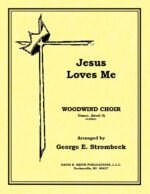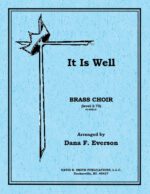| Writer | |
|---|---|
| Publisher |

C. T. Smith: A Symphonic Portrait
$15.95
Related products
-
Patriot’s Medley
$20.00Scored for the woodwind section of a concert band arrangement, this Easter celebration is presented with strong traditional thematic statements, all the while being surrounded by exuberant obligati features.
-
Jesus, Lover Of My Soul
$11.00Three Plus Flutes for three soprano with opt. 4th/ob. with alto and bass. An opening with an active top voice giving over to the lower voices doing the same. Then in block harmonic movement the pieces moves along with subtle harmonic shifts. The middle section continues in much the same fashion with dynamic shifts. The next area is the same fashion only this time with the lower voices carrying the activity and the upper voice in more solemn movement. The final section is more active with the top voice using material from the introduction and slows to repose.
-
-
-
It Is Well
$12.00Brass choir scored for four trumpets (opt horn) two trombones, baritone BC/TC and tuba. This entire piece is one of serenity, gentleness and great affect. The introduction is in the lower voices producing a rich sound and sense of expectation. The trumpets add in on the melody with long lines of expression, and then the lower voices offer a response in like manner. The next section increases in movement and dynamic until it modulates to a new key center. The phrases now alternate between the low voices in an almost antiphonal fashion. Another modulation elevates the urgency of the piece and the trumpets carry the entire load throughout this section. The rest of the instruments then bolster the ensemble giving increased strength. The pieces quiets and becomes reflective and then settles with an “all is well.”
-
He Is Born, The Divine Christ Child
$11.00Three Plus Flutes for three soprano with opt. 4th/ob. with alto and bass & piccolo. The piece gins in a spritely duet in the upper voices and reverses roles with the lower voices carrying the melody and duet lines. All four voices now join in a smooth, serene fashion until it gains dynamic and harmonic strength. A modulation upward with the tune in voice two, and an obbligato-like movement in part one, while the lower parts underpin with a simplistic, though active line. In the last section the parts become more active and excitement abounds until a final flourish establishes the end.







